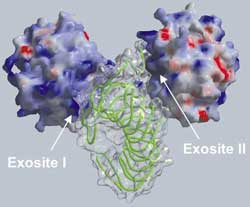BE.430J Fields, Forces, and Flows in Biological Systems, Fall 2004

Glycoprotein Ibα (GpIbα), a receptor on the surface of platelets in the blood, binds to several signaling molecules including thrombin, an enzyme released from damaged tissue that is required for blood clotting. This diagram shows the charge distribution on the surface of thrombin (red is negative, blue is positive). The GpIba receptor is shown in green with the surface rendered transparent. (Image courtesy of
Lawrence Berkeley National Laboratory.)
Highlights of this Course
Course Description
This course covers the following topics: conduction, diffusion, convection in electrolytes; fields in heterogeneous media; electrical double layers; Maxwell stress tensor and electrical forces in physiological systems; and fluid and solid continua: equations of motion useful for porous, hydrated biological tissues. Case studies considered include membrane transport; electrode interfaces; electrical, mechanical, and chemical transduction in tissues; electrophoretic and electroosmotic flows; diffusion/reaction; and ECG. The course also examines electromechanical and physicochemical interactions in biomaterials and cells; orthopaedic, cardiovascular, and other clinical examples.